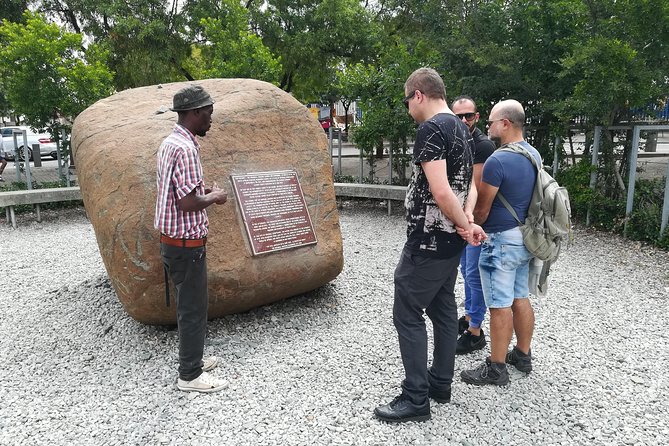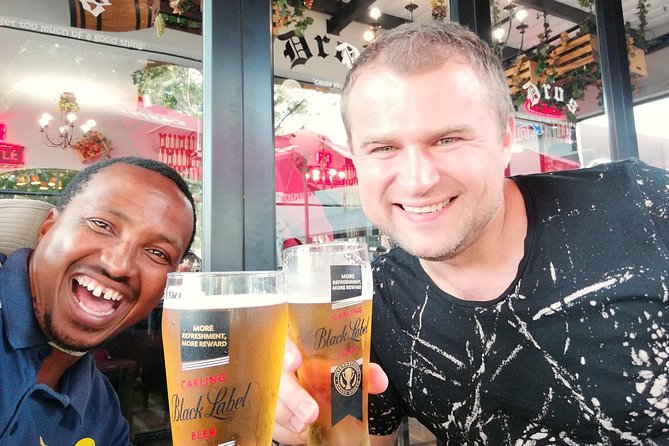As the sun sets over the sprawling township of Soweto, the echoes of a tumultuous past reverberate through its streets.
The Apartheid Museum stands as a sentinel, its walls bearing witness to the struggles and triumphs of a nation. It is here, in the heart of Johannesburg, that the story of apartheid unfolds in vivid detail, inviting visitors to step into the shoes of those who fought for justice and equality.
But the museum is just the beginning. Soweto, with its rich tapestry of history and culture, beckons explorers to delve deeper into its vibrant streets. From the iconic FNB Stadium to the hallowed halls of Mandela House, every corner of this township holds a story, waiting to be discovered.
So, lace up your shoes, and embark on a journey that will leave you forever changed.
Good To Know
- Historical transition from apartheid to democracy aimed to address past injustices and build a more equitable society
- Apartheid’s impact on education perpetuated inequalities and segregation
- The Apartheid Museum provides an interactive and thought-provoking experience that deepens understanding of South Africa’s past
- Exploring Soweto Township offers insights into the significance of political activism, forced removals, and the resilience of the community
South Africa’s Historical Transition

South Africa’s historical transition from apartheid to democracy was a pivotal turning point in the nation’s journey towards equality and social justice. The political transformation marked the end of a dark era characterized by institutionalized racial segregation and discrimination. Apartheid’s impact on education was particularly profound, as it perpetuated inequalities and denied equal opportunities to black South Africans.
Under apartheid, schools were segregated based on race, with black students receiving inferior resources and education compared to their white counterparts. The transition to democracy brought about significant changes in the education system, aiming to address the injustices of the past. Efforts were made to promote inclusive education and provide equal access to quality schooling for all South Africans, regardless of their racial background.
This shift in education policy reflected the broader goal of building a more equitable and just society in post-apartheid South Africa.
Like museums? Other Pretoria cultural attractions we've reviewed
Apartheid Museum Highlights

The Apartheid Museum takes visitors on a captivating journey through South Africa’s history, providing a comprehensive exploration of the dark era of apartheid and its lasting consequences. Here are some highlights of the museum:
Interactive Exhibits: The museum offers a range of interactive exhibits that allow visitors to engage with the history of apartheid. From simulated experiences to thought-provoking displays, these exhibits provide a deeper understanding of the struggles faced by South Africans during this time.
Multimedia Presentations: Through the use of multimedia presentations, the museum brings the stories of apartheid to life. Visitors can watch videos, listen to oral histories, and view photographs that illustrate the impact of apartheid on individuals and communities.
Thought-provoking Experience: The Apartheid Museum aims to challenge visitors’ perceptions and provoke thoughtful reflection. By immersing visitors in the history and consequences of apartheid, the museum encourages a deeper understanding of South Africa’s past and its ongoing journey towards reconciliation.
Exploring Soweto Township
Nestled near Johannesburg, Soweto Township invites visitors to explore its rich history and experience the lasting effects of apartheid firsthand. As one of the largest townships in South Africa, Soweto played a significant role in the country’s political activism during the apartheid era.
Exploring Soweto offers a glimpse into township life and the struggles faced by its residents. Visitors can witness the impact of forced removals and segregation, which resulted in lasting inequalities. Soweto is home to iconic landmarks such as FNB Stadium, where Nelson Mandela addressed a crowd after his release from prison, and Mandela House, where he lived. Vilakazi Street, the only street in the world that has been home to two Nobel Prize winners, further showcases the township’s historical importance.
Engaging with locals provides a unique cultural experience, as residents share their personal stories and perspectives on apartheid, highlighting the resilience and spirit of the community.
Impact of Apartheid on Society
Apartheid’s profound impact on South African society reverberates through the struggles and inequalities that still persist today. The lasting inequalities caused by apartheid have left a deep mark on the country’s social fabric. Here are three key aspects of the impact of apartheid on society:
Forced removals and segregation: Apartheid policies led to the forced removals of non-white communities and the implementation of strict segregation laws. These actions resulted in the displacement of millions of people and the fragmentation of communities.
Economic disparities: Apartheid entrenched economic inequalities, with non-white populations facing limited opportunities for education, employment, and economic mobility. Today, these disparities continue to hinder the overall development and progress of the country.
Resilience and spirit: Despite the challenges imposed by apartheid, South African society has shown remarkable resilience and a strong spirit of determination. The struggle for equality and the triumph of democracy are testaments to the indomitable human spirit.
The impact of apartheid on society is a stark reminder of the importance of acknowledging and addressing past injustices to build a more equitable future.
Engaging With Soweto’s Locals
Enjoy the vibrant culture and rich history of Soweto by engaging with its welcoming and passionate locals. Soweto is a community that has faced adversity with resilience and strength, and by interacting with its residents, visitors can gain a deeper understanding of intercultural exchange and the spirit of community resilience.
Here is a table that highlights the benefits of engaging with Soweto’s locals:
| Benefits of Engaging With Soweto’s Locals |
|---|
| Gain insights into daily lives and experiences |
| Hear personal stories and perspectives on apartheid |
| Learn about the resilience and spirit of the community |
Engaging with the locals offers a unique cultural experience, allowing visitors to learn firsthand about the impact of apartheid and the ongoing efforts to overcome its legacy. By fostering connections and building relationships, visitors can contribute to a more comprehensive understanding of South African society and promote intercultural exchange. So, don’t miss the opportunity to engage with the passionate locals of Soweto and be inspired by their stories of strength and community resilience.
Common Questions
How Did the Transition From Apartheid to Democracy in South Africa Impact the Daily Lives of Its Citizens?
The transition from apartheid to democracy in South Africa had a profound impact on the daily lives of its citizens. It brought about increased access to education and economic opportunities, empowering individuals and creating a more inclusive society.
What Are Some Lesser-Known Artifacts or Exhibits at the Apartheid Museum That Provide Unique Insights Into the Apartheid Era?
Some lesser-known artifacts and exhibits at the Apartheid Museum provide unique insights into the apartheid era. Visitors can discover personal items, documents, and artworks that shed light on the experiences and struggles of those affected by this oppressive system.
How Has Soweto Township Evolved Since the End of Apartheid and What Ongoing Challenges Does It Face?
Since the end of apartheid, Soweto township has evolved in many ways. However, it still faces ongoing challenges. These challenges include high unemployment rates, inadequate infrastructure, and persistent social and economic inequalities.
In What Ways Did Apartheid Policies Affect Different Racial and Ethnic Groups in South Africa?
Apartheid policies affected different racial and ethnic groups in South Africa in various ways. They created economic disparities and limited access to education, perpetuating inequalities that continue to impact these groups today.
How Have the Residents of Soweto Township Continued to Resist and Challenge the Lingering Effects of Apartheid in Their Community?
Residents of Soweto township continue to resist and challenge the lingering effects of apartheid through various tactics. They employ community empowerment initiatives, raise awareness, and promote social justice, fostering a sense of unity and resilience among themselves.
The Sum Up
To sum it up, the Apartheid Museum and Soweto offer a captivating glimpse into South Africa’s history and the impact of apartheid on its society.
By visiting these significant historical sites, visitors not only gain a deeper understanding of the struggle for equality and democracy but also have the opportunity to engage with locals in Soweto, hearing personal stories and perspectives that further enrich their cultural experience.
Exploring these sites is a must for anyone seeking to learn about South Africa’s complex past and its journey towards a more inclusive future.
More Museum Tours in Pretoria
- Johannesburg: Pretoria and Soweto via Apartheid Museum
- Johannesburg and PTA: Soweto and Apartheid Museum Day Tour
- Private Johannesburg and Soweto With Apartheid Museum Tour
- Private Tour of Gauteng: Pretoria, Apartheid Museum & Soweto
- Johannesburg and Apartheid Museum Private Tour
- Full Day Tour Apartheid Museum and Soweto
More Tour Reviews in Pretoria
Looking for something different? Other Pretoria activities we've written about
- Johannesburg: Pretoria and Soweto via Apartheid Museum
- Johannesburg and PTA: Soweto and Apartheid Museum Day Tour
- 25 Best Guided Tours In Pretoria
- 7 Best Historical Tours In Pretoria
- 25 Best Tours In Pretoria
- 14 Best 3 Day Tours In Pretoria
- 5 Best Private Driver Services In Pretoria
- 8 Best 4 Day Tours In Pretoria
- 20 Best Full-Day Tours In Pretoria
- 25 Best Safari Tours In Pretoria
- 17 Best 2 Day Tours In Pretoria
- 25 Best Guided Tours In Pretoria
